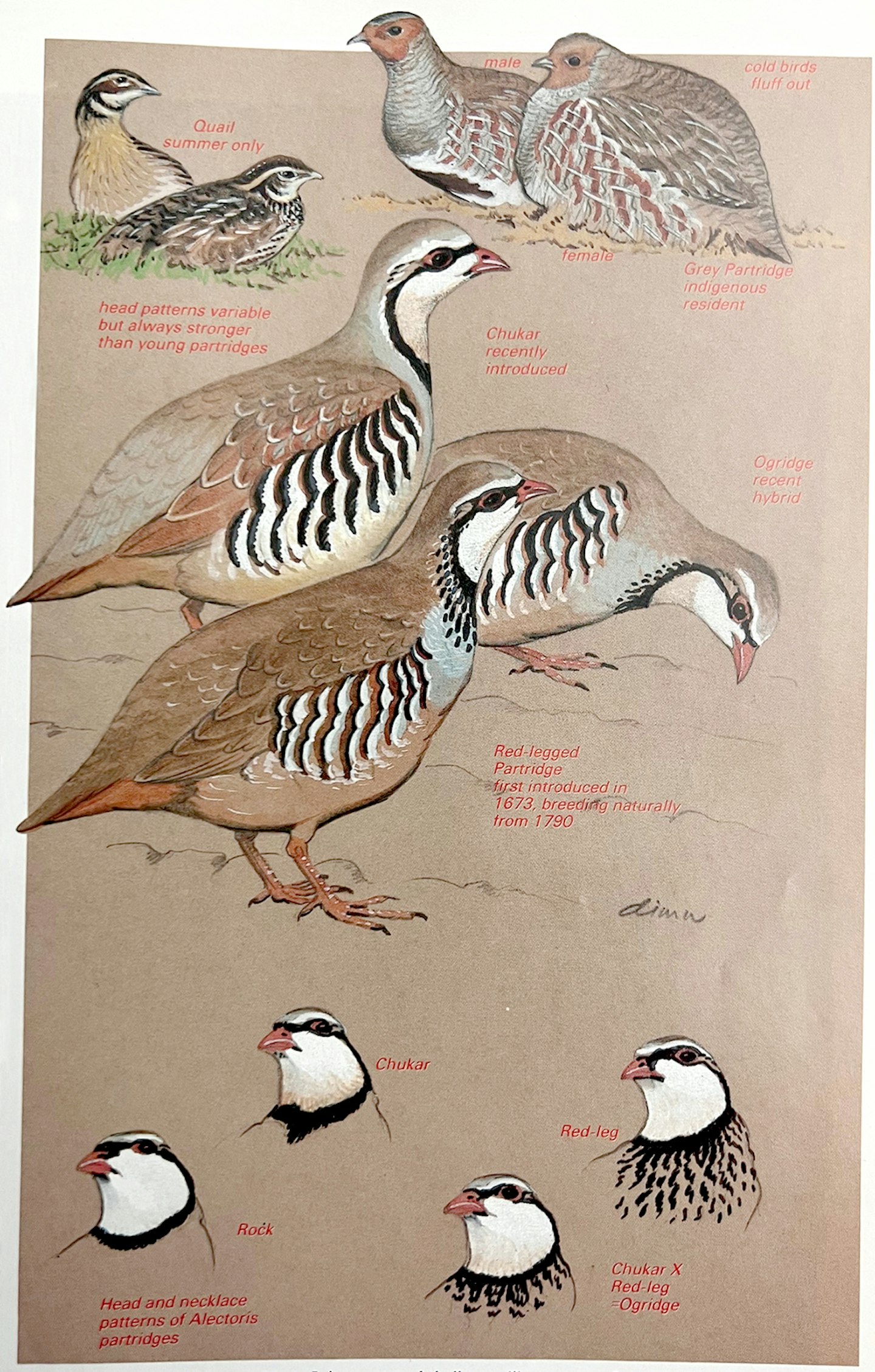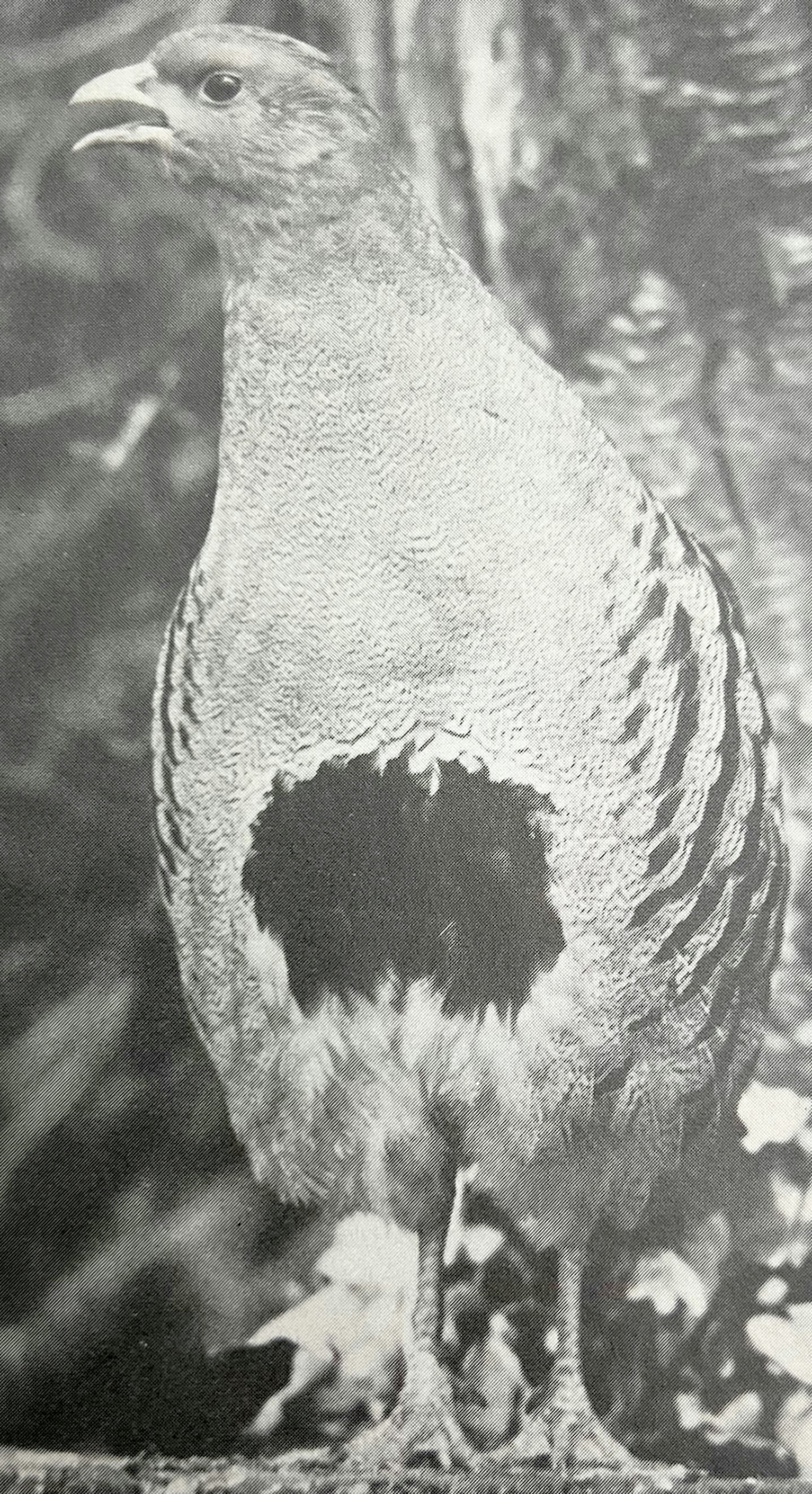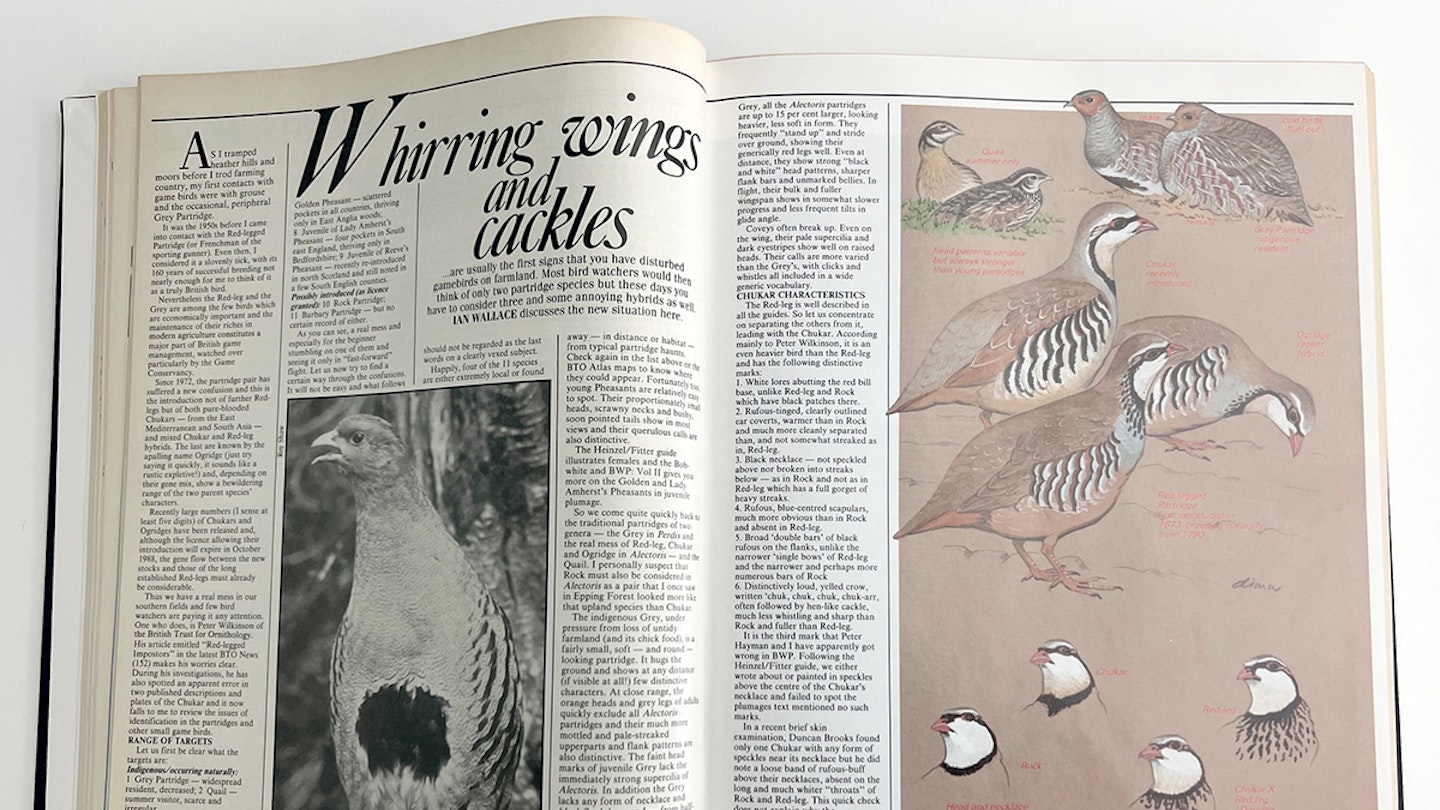Whirring wings and cackles
February 1988
Whirring wings and cackles are usually the first signs that you have disturbed gamebirds on farmland. Most bird watchers would then think of only two partridge species but these days you have to consider three and some annoying hybrids as well. Ian Wallace discusses the new situation here.
As I tramped heather hills and moors before I trod farming country, my first contacts with game birds were with grouse and the occasional, peripheral Grey Partridge.
It was the 1950s before I came into contact with the Red-legged Partridge (or Frenchman of the sporting gunner). Even then, I considered it a slovenly tick, with its 160 years of successful breeding not nearly enough for me to think of it as a truly British bird.
Nevertheless the Red-leg and the Grey are among the few birds which are economically important and the maintenance of their riches in modern agriculture constitutes a major part of British game management, watched over particularly by the Game Conservancy.
Since 1972, the partridge pair has suffered a new confusion and this is the introduction not of further Red – legs but of both pure-blooded Chukars – from the East Mediterranean and South Asia and mixed Chukar and Red-leg hybrids. The last are known by the apalling name Ogridge (just try saying it quickly, it sounds like a rustic expletive!) and, depending on their gene mix, show a bewildering range of the two parent species' characters.
Recently, large numbers (I sense at least five digits) of Chukars and Ogridges have been released and, although the licence allowing their introduction will expire in October 1988, the gene flow between the new stocks and those of the long established Red-legs must already be considerable.
Thus we have a real mess in our southern fields and few birdwatchers are paying it any attention. One who does, is Peter Wilkinson of the British Trust for Ornithology. His article entitled "Red-legged Impostors" in the latest BTO News (152) makes his worries clear. During his investigations, he has also spotted an apparent error in two published descriptions and plates of the Chukar and it now falls to me to review the issues of identification in the partridges and other small game birds.
Range of targets
Let us first be clear what the targets are:
Indigenous/occurring naturally:
1 Grey Partridge – widespread resident, decreased;
2 Quail summer visitor, scarce and irregular.
Long introduced for sport:
3 Red-legged Partridge – mainly east, central and South England, on drier soils;
4 Juvenile of Pheasant – wide spread except north-west Scotland. Recently introduced for sport:
5 Chukar (and Ogridge) – range not precisely known, probably mainly East Anglia and Home Counties.
Also introduced for sport or decoration:
6 Bobwhite – tenuous pockets on Tresco and in South England none large;
7 Juvenile of Golden Pheasant – scattered pockets in all countries, thriving only in East Anglia woods;
8 Juvenile of Lady Amherst's Pheasant four pockets in south-east England, thriving only in Bedfordshire;
9 Juvenile of Reeve's Pheasant – recently re-introduced in north Scotland and still noted in a few South English counties.
Possibly introduced (as licence granted):
10 Rock Partridge;
11 Barbary Partridge but no certain record of either.
As you can see, a real mess and especially for the beginner stumbling on one of them and seeing it only in "fast-forward'? flight. Let us now try to find a certain way through the confusions. It will not be easy and what follows should not be regarded as the last words on a clearly vexed subject.
Happily, four of the 11 species are either extremely local or found away – in distance or habitat from typical partridge haunts. Check again in the list above or the BTO Atlas maps to know where they could appear. Fortunately, too, voung Pheasants are relatively easy to spot. Their proportionately smal heads, scrawny necks and bushy, soon pointed tails show in most views and their querulous calls are also distinctive.
The Heinzel/Fitter guide illustrates females and the Bobwhite and BWP [Birds of the Western Palearctic]: Vol Il gives you more on the Golden and Lady Amherst's Pheasants in juvenile plumage.

Traditional partridges
So we come quite quickly back to the traditional partridges of two genera – the Grey in Perdix and the real mess of Red-leg, Chukar and Ogridge in Alectoris – and the Quail. I personally suspect that Rock must also be considered in Alectoris as a pair that I once saw in Epping Forest looked more like that upland species than Chukar.
The indigenous Grey, under pressure from loss of untidy farmland (and its chick food), is a fairly small, soft, and round-looking partridge. It hugs the ground and shows at any distance (if visible at all!) few distinctive characters. At close range, the orange heads and grey legs of adults quickly exclude all Alectoris partridges and their much more mottled and pale-streaked upperparts and flank patterns are also distinctive. The faint head marks of juvenile Grey lack the immediately strong supercilia of Alectoris. In addition the Grey lacks any form of necklace and black flank bars and – from half – side or front-erect adults show a dark "horseshoe" on their otherwise clear bellies.
In flight, Greys are not always distinguishable from Alectoris species but they "spring" more easily and quickly, do not usually. scatter and (again) may show their unmarked heads.
Their common grating disyllables, written 'keev-it' or ‘kee-vick', turn into rapid cackles in alarm but are usually quieter, thinner and less phrased than those of Alectoris partridges.
In quite distinct contrast to the Grey, all the Alectoris partridges are up to 15% larger, looking heavier, less soft in form. They frequently "stand up" and stride over ground, showing their generically red legs well. Even at distance, they show strong "black and white" head patterns, sharper flank bars and unmarked bellies. In flight, their bulk and fuller wingspan shows in somewhat slower progress and less frequent tilts in glide angle.
Coveys often break up. Even on the wing, their pale supercilia and dark eyestripes show well on raised heads. Their calls are more varied than the Grey's, with clicks and whistles all included in a wide generic vocabulary.

Chukar characteristics
The Red-leg is well described in all the guides. So let us concentrate on separating the others from it, leading with the Chukar. According mainly to Peter Wilkinson, it is an even heavier bird than the Red-leg and has the following distinctive marks:
1. White lores abutting the red bill base, unlike Red-leg and Rock which have black patches there.
2. Rufous-tinged, clearly outlined ear coverts, warmer than in Rock and much more cleanly separated than, and not somewhat streaked as in, Red-leg.
3. Black necklace – not speckled above nor broken into streaks below _ as in Rock and not as in Red-leg which has a full gorget of heavy streaks.
4. Rufous, blue-centred scapulars, much more obvious than in Rock and absent in Red-leg.
5. Broad 'double bars' of black rufous on the flanks, unlike the narrower 'single bows' of Red-leg and the narrower and perhaps more numerous bars of Rock
6. Distinctively loud, yelled crow, written ‘chuk, chuk, chuk, chuk-arr’, often followed by hen-like cackle, much less whistling and sharp than Rock and fuller than Red-leg.
It is the third mark that Peter Hayman and I have apparently got wrong in BWP. Following the Heinzel/Fitter guide, we either wrote about or painted in speckles above the centre of the Chukar's necklace and failed to spot the plumages text mentioned no such marks.
In a recent brief skin examination, Duncan Brooks found only one Chukar with any form of speckles near its necklace but he did note a loose band of rufous-buff above their necklaces, absent on the long and much whiter "throats" of Rock and Red-leg. This quick check does not explain why the Heinzel/Fitter guide enshrined the speckling and I have to add that one pure-blooded Chukar that I handled in Jordan had a broken necklace. So, as ever, in bird identification, even the newest rules may have exceptions. Separation on single characters are never unsafe. Finally we should also remember that the necklace of the Rock is evenly rounded and does not project downwards on its breast, as in Chukar, and its small ear spot is glossy fulvous, not large and rufous as in Chukar.
Hybrid Alectoris partridges could show every intergradation among the characters described above.
Quail
Who would have thought that partridges could have become so troublesome? It is a relief to turn at last to the Quail. It is almost 50% smaller than any partridge and lacks any obvious marks, except for the dark patched or striped face and throat pattern shown by birds (particularly males) at close range.
It is a perpetual skulker, unlike partridges which are just difficult to see, but it does have a totally individual voice, of which the classic ‘wet-my-lips’ or, better, ‘quick – lick, lick’ is the loudest and commonest call.
In its rather weak flight, its upperparts show a Snipe-like pattern and its tail is uniform with the rest, not boldly chestnut-sided as in all partridges. It may be that the release of odd Alectoris will end next year but in the meantime it will make sense to cheek your local partridges more closely than ever before – and report any suspicious birds to your local recorder, please!
In attempting this review, I have been helped by Peter Wilkinson and Duncan Brooks. Any further miscues are mine, not theirs.
2020s update
Lady Amherst’s Pheasant is now extinct or very close to extinct in the UK (even in its last stronghold of Bedfordshire), as is Reeve’s Pheasant. Golden Pheasant is very localised and rare, with up to 100 pairs still ‘in the wild’.
Though Red-legged Partridges (73,000 pairs) are now commoner than native Greys (37,000 pairs), the other Alectoris species (and hybrids) are very rarely seen these days, with the likes of Chukar (and Rock Partridge) being illegal to release from 1993.
